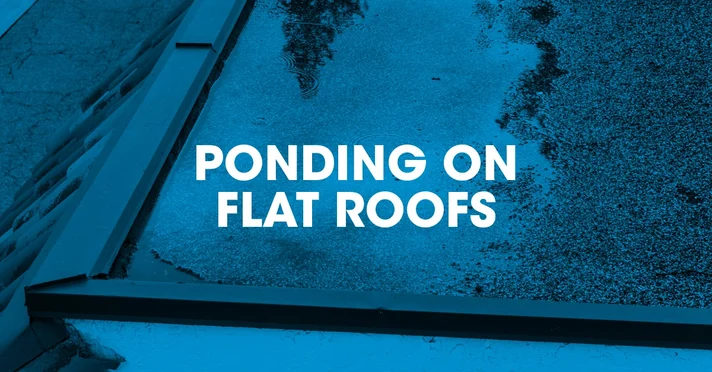This article discusses the acceptable duration for water pooling on flat roofs in the UK. With insight from industry experts and building regulations, this guide helps address ponding issues to prevent roof damage. Image: LABC Warranty Ponding that drains away within 48 hours is typically considered acceptable. However, any standing water persisting beyond this timeframe should prompt attention to address potential issues with drainage or roof slope. While a minimum slope of 1:40 is generally recommended by UK building regulations, steeper slopes like 1:60 may be necessary depending on the roof covering and local climate conditions for effective drainage. While temporary ponding after rainfall is normal, flat roofs in the UK should be designed and constructed to ensure proper drainage. Prolonged pooling of water can lead to damage, so addressing areas of standing water through improved drainage or slope adjustments can help prevent costly repairs. Ponding that drains away or evaporates within 48 hours is generally considered acceptable for flat roofs in the UK. However, recurring ponding or areas with insufficient falls can pose long-term issues. The National Roofing Contractors Association notes that standing water remaining on a flat roof for 24-48 hours signals potential drainage problems. While prolonged pooling beyond 48 hours is often considered safe, addressing water accumulation promptly is crucial to prevent damage. UK building regulations stipulate a minimum fall of 1:40 for flat roofs to ensure adequate drainage. The acceptable level of pooled water on a flat roof in Surrey varies depending on factors like roof design, construction, and the effectiveness of waterproofing measures and built-in falls. To resolve ponding issues, consulting a roofing contractor to assess the roof and recommend appropriate solutions is recommended. Proper construction and ongoing maintenance are vital for managing occasional ponding. Nevertheless, addressing excessive or prolonged pooling promptly is advisable to mitigate potential risks of roof leaks and deterioration. Ponding that drains away or evaporates within 48 hours is acceptable for flat roofs. However, regular occurrences of ponding and areas with incorrect falls can be problematic. Any amount of standing water that remains on a flat roof for 24 to 48 hours is a concern. Prolonged ponding for 48 hours is considered a typical safe duration for pools of rainfall. The building regulations recommend a minimum fall of 1:40 for flat roofs. It is important to address pooling on flat roofs to prevent damage. Some temporary ponding after rain is normal, but water should drain within 48 hours. Ponding that drains away or evaporates within 48 hours is considered acceptable for flat roofs in the UK. However, regular occurrences of ponding and areas with incorrect falls can be problematic. The building regulations recommend a minimum fall of 1:40 for flat roofs. The amount of acceptable ponding water on a flat roof will depend on the design and construction of the roof. It is important to address pooling to prevent damage.
How Much Ponding Is Acceptable on a Flat Roof UK?

Key Points
Our Opinion
Acceptable Ponding Duration on a Flat Roof
Factors Influencing Ponding on Flat Roofs
BS Standards for Ponding on Flat Roofs
Recommended Falls for Flat Roofs
FAQ
What is acceptable ponding on a flat roof?
How much water should sit on a flat roof?
What is the minimum fall on a flat roof per Metre?
Is standing water normal on a flat roof?
Conclusion

